最新人教版八年级英语下册Unit 2 单元教案
- 格式:doc
- 大小:16.25 MB
- 文档页数:57
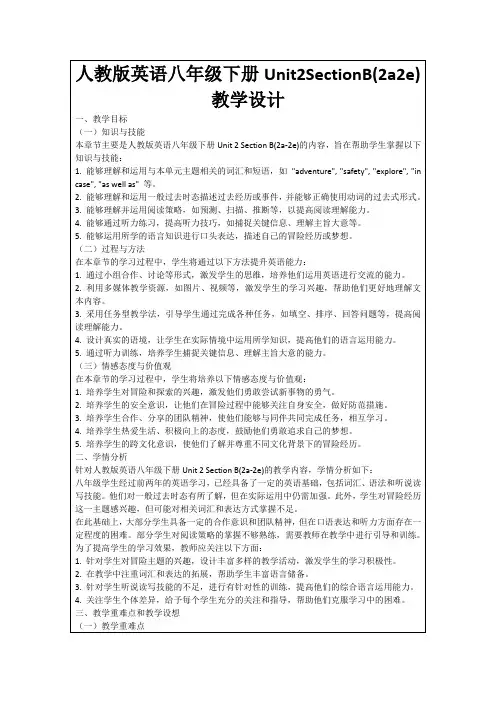
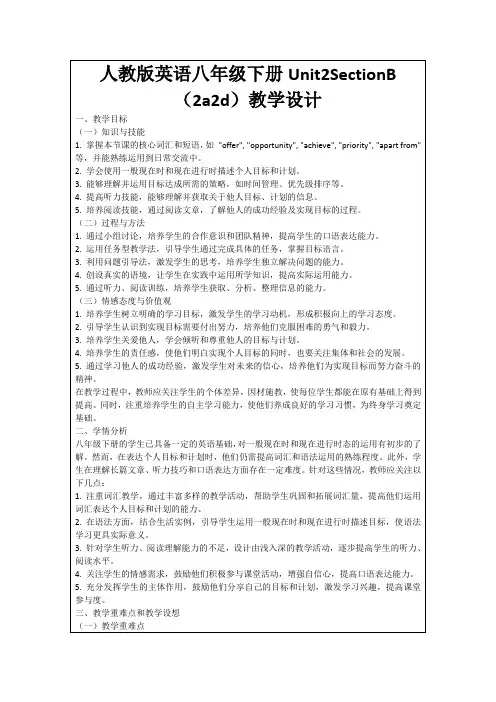
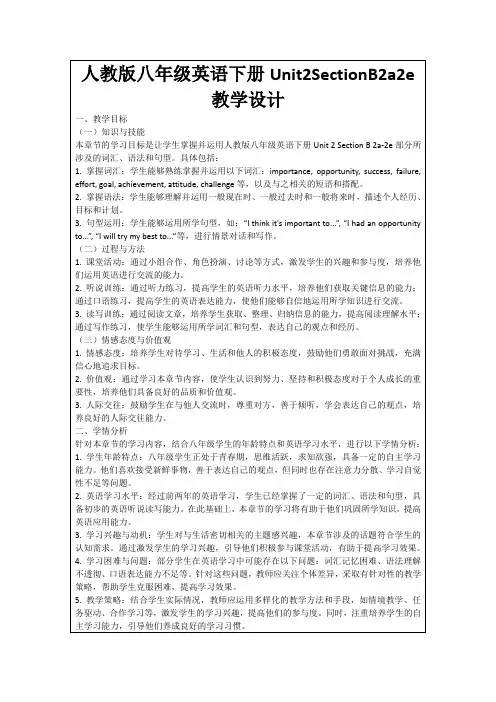
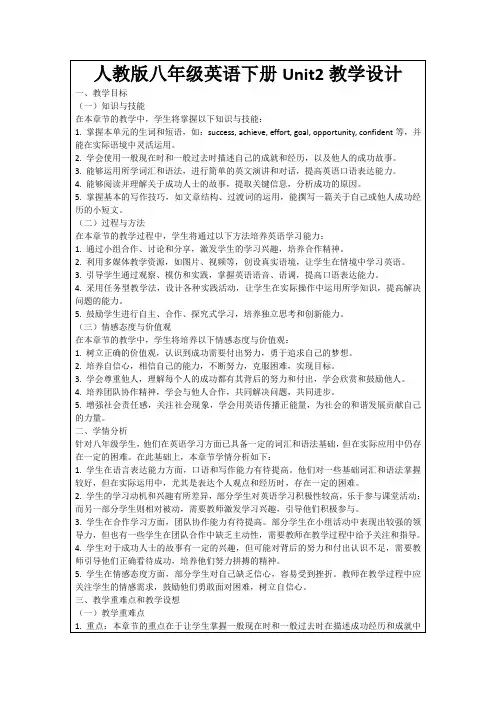
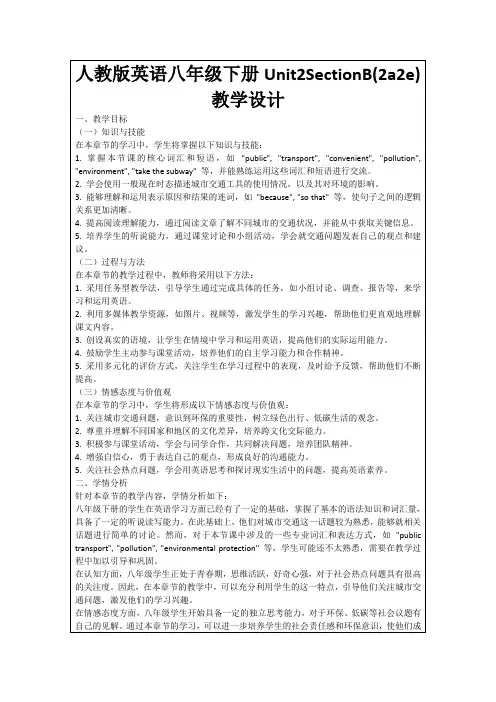
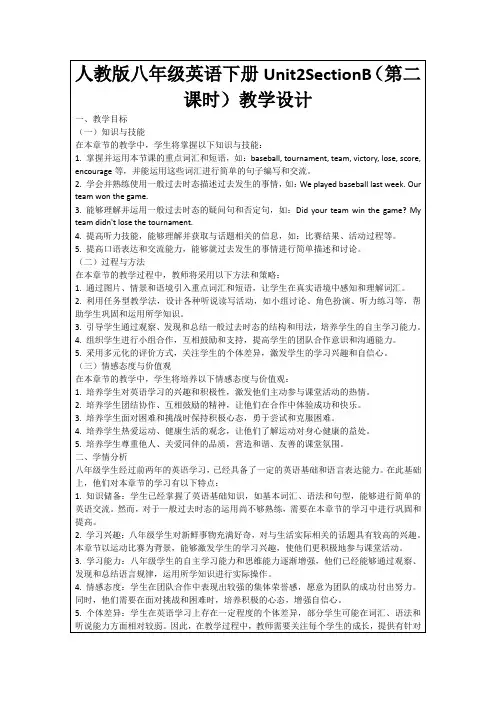
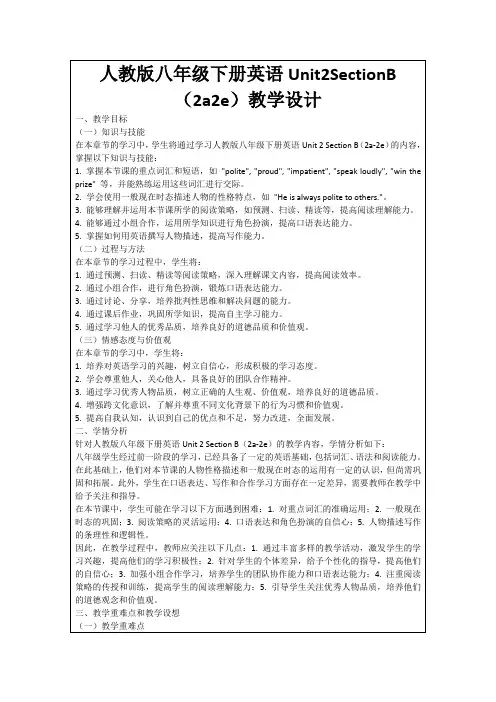
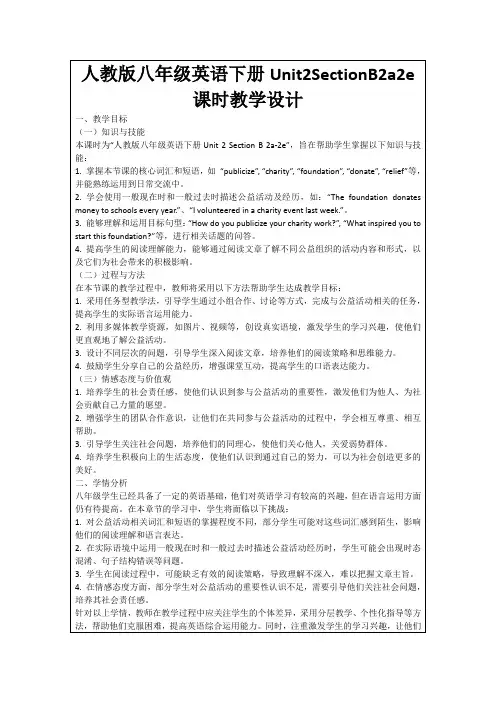
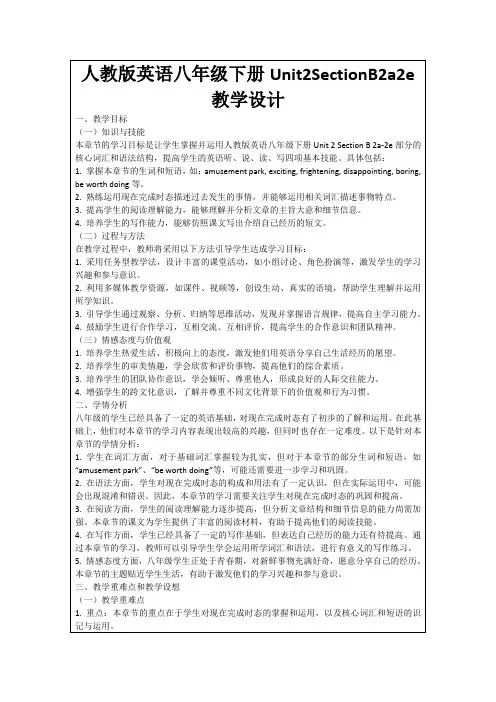
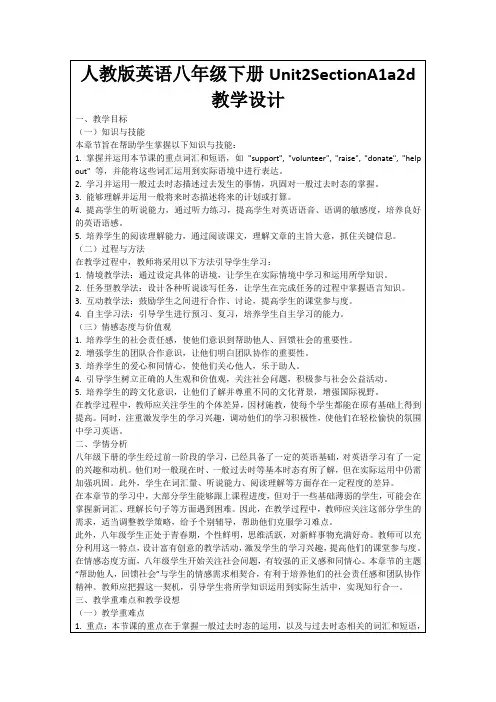
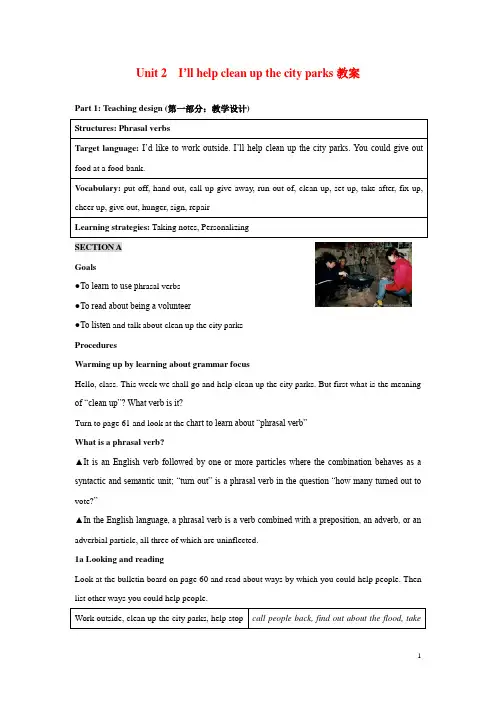
Unit 2 I’ll help clean up the city parks教案Part 1: Teaching design (第一部分:教学设计)SECTION AGoals●To learn to use p hrasal verbs●To read about being a volunteer●To listen and talk about clean up the city parksProceduresWarming up by learning about grammar focusHello, class. This week we shall go and help clean up the city parks. But first what is the meaning of “clean up”? What verb is it?Turn to page 61 and look at the chart to learn about “phrasal verb”What is a phrasal verb?▲It is an English verb followed by one or more particles where the combination behaves as a syntactic and semantic unit; “turn out” is a phrasal verb in the question “how many turned out to vote?”▲In the English language, a phrasal verb is a verb combined with a preposition, an adverb, or an adverbial particle, all three of which are uninflected.1a Looking and readingLook at the bulletin board on page 60 and read about ways by which you could help people. Then list other ways you could help people.1b Listening and completingYou are going to listen to several conversations.While listening, pay attention to information to complete the sentences on page 60 in the box.1c Doing pairworkIn pairs you are to practice the conversations in the picture on page 60. Then make similar conversations using the information in activity 1b.We could help stop hunger by giving out food2a Listening and checkingSome students talking about planning a City Parks Clean-up Day. Listen to their talk and check√the things they are going to do.2b Listening and filling in blanksI’ shall play t he tape again and you are to listen and fill in the blanks in the box on 61.2c Doing pairworkLet’s go on to role play the conversation in activity 2b.3a Reading, underlining and circlingOn page 62 is an article about volunteers. Read it and underline the kinds of work they do. YouRead the article again to darken the phrasal verbs found in it.3b Filling in the tableOn page 62 is a table showing the kinds of volunteer work the four students could do. Read thetable and fill in it.3c Doing pairNext take turns role playing being one of the people in 3b by asking and giving advice.4 Doing pairworkIn the table on bottom of page 62 write down three things you like to do and then ask your partner for advice about the kinds of volunteer work you could do.Closing down by reading an English poemFalling Asleep in ClassI fell asleep in class today,as I was awfully bored.I laid my head upon my deskand closed my eyes and snored.I woke to find a piece of papersticking to my face.I'd slobbered on my textbooksand my hair was a disgrace.My clothes were badly rumpledand my eyes were glazed and red.My binder left a three-ringindentation in my head.I slept through class, and probablyI would have slept some more,except my students woke meas they headed out the door.Kenn NesbittSECTION B●To Learn more phrasal verbs●To listen, speak and write using phrasal verbsProceduresWarming up by brainstorming phrasal verbsHello, everyone. To begin with, we shall brainstorm a list of phrasal verbs.On page 63 is a box with 4 sentences. Match them with their similar meanings on the right.1b Making sentencesOn page 63 you will find a box with some phrasal verbs. Make a sentence with each of the phrasalverbs.2a Listening and numberingListen to the recording that I am going to play and number the pictures on page 63. (Key:a4,b2,c1,d3 )2b Listening and circlingYou shall listen to the recording again to circle “T” or “F”.2c Doing pairworkIn pairs practice the conversations between Jmmy and the reporter. Use the information from the activities on page 63.3a Reading and underliningOn page 64 is an article about Jimmy the Bike Boy. Read to understand it and underline all the phrasal verbs.Copy all the phrasal verbs and useful expressions onto your notebook.3b Making a noteRead the article again to make a note of the things that Jimmy did in order to sole his problem.1.He did a radio interview.2.He also put up some signs asking for old bikes.3.He called up all his friends and told them about the problem.4.He even handed out advertisements at a local supermarket.5.He told the teachers at school about his problem and they set up a call-in center for parents.4 Doing groupworkBy brainstorming work out a plan for helping out in your community. Write down where and what you will volunteer and tell your classmates about your plan.Closing down by talking about volunteer workLook at the pictures below and talk about the volunteer work that the people in the pictures aredoing.SELF CHECK1.Filling and makingTurn to page 65 and fill in the blank with a correct word given in its correct form. Then make a sentence with each of the given words.2 Writing an article tell about SallyOn page 65 is a box with words and phrases. Write an article telling about what happens to Sally.Just for funLook at the pictures and make a storyout of them.Reading: I’ll send you a photo ofLucky.Before you read, listen to the recording without looking at the article.While you read,underline all the phrasal verbs, blacken all the expressions all the linking words.After you read, copy down all the phrasal verbs and useful expressions into your notebook.Part 2: Teaching Resources (第二部分:教学资源)I. What is a volunteer?A volunteer is someone who performs or offers to perform a service out of his own free will, oftenwithout payment. The year 2001 was the International Year of the Volunteer. 2005 is the UK Year of the Volunteer.People may volunteer to perform some work, e.g., of charitable character. Some volunteer for clinical trials or other medical research, and may even donate their bodies to science after their death.II. What is an online Volunteer?An online volunteer is a person who contributes time and effort with an organization through an online connection, rather than in person. A wide variety of people from around the world are online volunteers and most are not technology professionals.Online volunteers may provide advice, consultancy and perform remote administration tasks for the organisation, usually a charity or non-profit organisation. The practice of donating time online goes by other names, such as virtual volunteering, cyber service, telementoring, e-volunteering, and cyber volunteering.There are many opportunities for people to donate their services using the internet. Online volunteers do a variety of tasks, such as translating documents, editing or preparing proposals, designing logos, researching information, developing strategic plans, reviewing budgets, creating web pages, designing flash presentations, moderating online discussion groups and managing other online volunteers.III. What is an ICT Volunteer?An ICT volunteer is someone who is working to foster the implementation and use of Information and Communication Technologies. He or she can install hardware, software or carry on with ICT training programmes. There is no need to be an online volunteer to be an ICT volunteer: installing hardware is a good example. Likewise, there is no need to be an ICT volunteer to be an online volunteer: teaching a language through a virtual campus is not related with ICT fostering, at least in a direct way.....。
Unit 2 I’ll help to clean up the city parks.The first period:New words and phrasesTeaching and Learning Goals:一、词汇和常用表达:1. 能争取使用下列词汇(Curriculum words)volunteer, sign, notice, lonely, several, strong, feeling, satisfaction, joy, owner, journey, raise, alone, repair, broken, wheel, letter, disabled, blind, deaf, imagine, difficulty, open, door, carry, train, excited, training, kindness, lever, understand, change, interest, sir, madam2. 能争取使用下列常用短语(Useful expressions)clean up , cheer up, give out, come up with, put off, hand out, call up, used to, care for, try out, fix up, give away, take after, set up, make a difference,二、技能目标:听懂“帮助他人,参加社会公益活动”的相关话题及文章;掌握向别人求助或提供帮助的一些句式;掌握短语动词及动词不定式的一些用法。
三、情感教育:学会关注身边的生活环境,关注他人,社会,利用自己的特长为他人、社会做贡献,投身于社会公益活动,增强社会责任感。
Teaching and learning stepsStep 1:Learn to read the words1. Ask the students to read the words by themselves using the phonetics and underline the difficult words, such as volunteer, satisfaction, journey, imagine...2. Encourage the students to read the difficult words with their partners.3. Get two or three students to read all of the words. Ask some other students to correct the pronunciation as possible as they can. If necessary, the teacher corrects them.4. Read the words after the tape and imitate the pronunciation.5. The students read the words aloud themselves while the teacher walks around the class to see if the students have any questions.[操作说明] 首先由学生自己根据音标识读单词,并标划出识读时有困难的单词。
鼓励学生以两人一组为单位解决有困难的单词。
接着找两三个同学读单词,如果有发音错误,请其他学生先纠正,必要时,教师再更正。
然后让学生跟录音读,模仿发音,最后学生再自由,教师解决学生可能遇到的问题。
【设计意图】该步骤能有效培养学生个人识读单词的学习习惯,这是学习单词的重要一步;能培养学生自主、探究和合作学习的能力。
Step 2 : Remember the wordsA.Remember some of the words by looking at the pictures and the sentences .volunteer1. She is a volunteer (n.). She volunteers(v.) to help others.sign2. Look at the sign. It says: No smoking!notice3. I notice (v.) a new notice(n.) on the wall .journey4. They are having a long journey.wheel5. A bike has two wheels.letter6. This is a thank-you letter.blind deafHelen Keller is a blind and deaf woman . But she is very great.open door7. She is opening the door.[操作说明] 运用课件、图画和动作等创设语境,让学生直观地理解单词的意思。
【设计意图】利用语句促进理解,加深记忆,培养学生用英语思维的习惯。
B. Remember some of the words by conversion (转换), derivative(派生)and similar meaning.1.转换①I want to be a volunteer. (名词) I volunteer to help the old. (动词)②I notice (动词) a new notice(名词.) on the wall③Great changes(名词)have taken place in Zaozhuang.Thanks for changing(动词)my life.④The beautiful pictures interest(动词)me. My brother has many interests(名词)andhobbies.2. 派生①feeling感觉,感触:feel( 感觉)+ing②satisfaction 满足,满意:satisfy(使高兴)去y +action③owner物主,主人:own(自己的)+er④disabled 残疾的:dis+ able(有能力的) +d⑤difficulty困难:difficult(困难的) +y⑥excited 激动的:excite(使激动) +d⑦kindness 仁慈,善良:kind(和蔼的) +ness3.近义词或近义短语①several: a few, some②joy: happiness③lonely: alone④repair: fix up⑤take after: look like⑥clever: smart⑦care for: look after; take care of⑧call up: telephone⑨give out: hand out【设计意图】根据构词法(转换、派生和近义词等方法)记忆单词非常有效。
英语的词汇无限,英语的词根有限,很多词是通过附加词缀变化而来,或是转换,或是派生而来的。
)C. Remember the phase by matching Column A with Column B.A B1. clean up振奋起来2. cheer up建立3. set up打扫干净4. give away赠送5. put off 参加…选拔6.try out 推迟e up with 曾经ed to 影响9.make a difference想出,提出【设计意图】语块记忆即关注词的搭配是一种有效的记忆短语的方式。
Step 3: Consolidate the words and phrases1. Ask the students to read the words and phrases and their Chinese of Unit 1 on Page 116 and Page117. Cover the English words and phrases , look at the Chinese and say the English for them. W rite down the words they haven’t grasped.2. Ask the students to read the words and phrases and try to remember them. Then have a[操作说明] 先让学生速记5分钟,然后将学生分成男女组采用英汉互译的方法进行PK。
【设计意图】为巩固单词,让学生读记本单元单词。
然后将学生分成男女组采用英汉互译的方法进行PK。
激发学生兴趣,让学生动起来。
Step 4 :Read and translate1. Ask the students to read the passage and translate it into Chinese.Jim is a clever boy with kindness. He takes after hisfather. He likes volunteering and caring for others.He used to help to clean up the city parks and raisemoney for the children who were sick or poor. When he sawthose children get better or the look of joy on their faces, hehad a strong feeling of satisfaction.Now he comes up with a new idea. He gives outsome notices and calls up friends to collect old or brokenbikes for himHe now has sixteen bikes to fix up and gives away tochildren who don’t have bikes.【设计意图】词汇教学应采用词—句—文的教学模式,让学生将单词用到句子和语篇中。
在学生记忆本单元单词的基础上,再学习由本单元的生词编成的一篇文章,体现了词不离句、句不离文的教学原则,有助于学生学习理解和使用本单元的词汇。